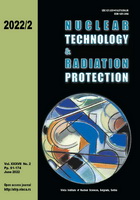
COMPARATIVE STUDY OF THE MeV ION CHANNELING IMPLANTATION INDUCED DAMAGE IN 6H-SiC BY THE ITERATIVE PROCEDURE AND PHENOMENOLOGICAL CSIM COMPUTER CODE
Pages: 128-137
Authors: Marko P. Gloginjić, Marko V. Erich, Željko V. Mravik, Branislav Vrban, Štefan Čerba, Jakub Lüley, Vendula Filová, Karel Katovský, Ondej Štastny, Jiri Burian, and Srdjan M. PetrovićAbstract
Due to its unique material properties, such as extreme hardness and radiation resistance, silicon carbide has been used as an important construction material for environments with extreme conditions, like those present in nuclear reactors. As such, it is constantly exposed to energetic particles (e. g., neutrons) and consequently subjected to gradual crystal lattice degradation. In this article, the 6H-SiC crystal damage has been simulated by the implantation of 4 MeV C3+ ions in the (0001) axial direction of a single 6H-SiC crystal to the ion fluences of 1.359·1015 cm-2, 6.740·1015 cm-2, and 2.02·1016 cm-2. These implanted samples were subsequently analyzed by Rutherford and elastic backscattering spectrometry in the channeling orientation (RBS/C & EBS/C) by the usage of 1 MeV protons. Obtained spectra were analyzed by channeling simulation phenomenological computer code (CSIM) to obtain quantitative crystal damage depth profiles. The difference between the positions of damage profile maxima obtained by CSIM code and one simulated with stopping and range of ions in matter (SRIM), a Monte Carlo based computer code focused on ion implantation simulation in random crystal direction only, is about 10 %. Therefore, due to small profile depth shifts, the usage of the iterative procedure for calculating crystal damage depth profiles is proposed. It was shown that profiles obtained by iterative procedure show very good agreement with the ones obtained with CSIM code. Additionally, with the introduction of channeling to random energy loss ratio the energy to depth profile scale conversion, the agreement with CSIM profiles becomes excellent.
Key words: silicon carbide, computer simulation, iterative procedure, RBS/C and EBS/C spectrometry
FULL PAPER IN PDF FORMAT (1,42 MB)
